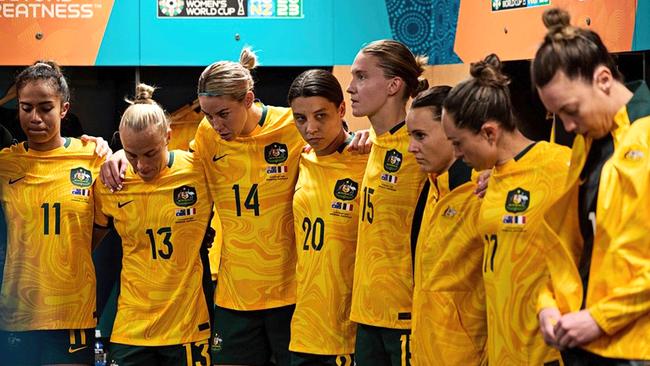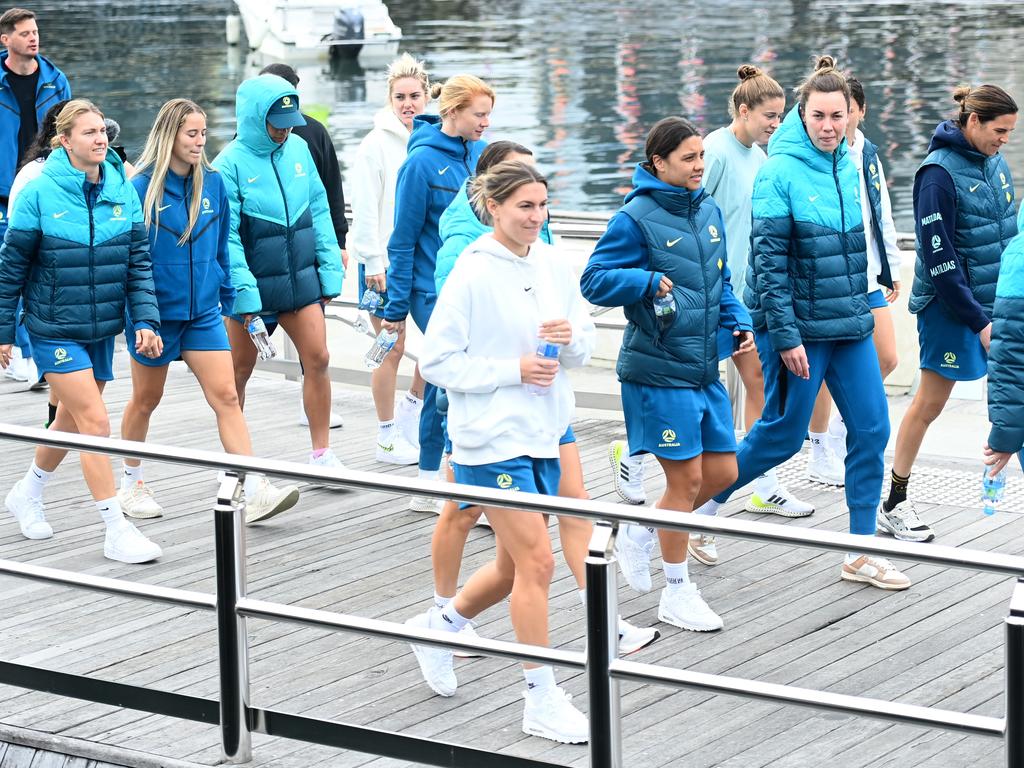The team that changed everything: How Operation Matildas won over a nation
Australia is in love with the Matildas. But it was not always the case, and the World Cup has exceeded even the most optimistic of projections thanks to the team’s surge to the semi-finals.

It is the first $1bn Women’s World Cup in history, riding the wave of Matildas mania that has gripped Australia.
The World Cup has exceeded even the most optimistic of projections, whether it be in financial, economic, wider sporting and even political terms.
Wednesday night’s 80,000 crowd for the Australia versus England semi-final at Sydney’s Stadium Australia, and the same number for Sunday’s final, will help push the total attendance for the four-week tournament across Australia and New Zealand to about 1.9 million.
It is a far cry from when the Matildas hosted Brazil in 2014 in Brisbane over two matches – the first attracted just 2600 fans and the second was played behind closed doors because it was too costly to open the gates.
But Australia has finally woken up to how good the Matildas are, with established stars such as Sam Kerr being joined by new ones like Mary Fowler and Mackenzie Arnold.
A deliberate strategy by Football Australia to invest in the Matildas as a brand since winning hosting rights in mid-2020 has fuelled a boom in the interest in women’s soccer.
Cheap tickets at family-friendly prices including just $10 for children at some games has meant diverse – and particularly younger – crowds at matches and broken attendance records for women’s sport in most stadiums.
This World Cup’s $US100m in ticket sales is not even the biggest number for world governing body FIFA.
Add in another $US300m in sponsorship from giants like Adidas, Coca-Cola and McDonald’s, and the same amount for global broadcast rights, VIP and corporate box sales, and the $1bn threshold is passed for the first time in what is the ninth Women’s World Cup.
“It has been bigger than we had expected, that is simply a fact,” said Football Australia chief executive James Johnson.
“Whether you’re talking about crowds at games, television audiences, merchandise and sales of scarfs and beanies, absolutely everything has exceeded what we hoped it would be.”
Suddenly, the Matildas are the hottest ticket in town. Prime Minister Anthony Albanese and Sports Minister Anika Wells were attending Wednesday night’s game, as pressure on the government – which is putting $240m towards an AFL stadium in Hobart – to fund grassroots soccer, especially for much-needed facilities for girls inspired by the Matildas, heats up.
Television network bosses were also there, including Nine Entertainment CEO Mike Sneesby and Ten’s Jarrod Villani and Beverley McGarvey, and Optus boss Kelly Bayer Rosmarin, as well as Commonwealth Bank CEO Matt Comyn.
The TV bosses were feted by FIFA global president Gianni Infantino and secretary-general Fatma Samoura, who hope to double the Australian broadcast rights for the next men’s and women’s World Cups given the huge interest in this year’s tournament.
Seven West Media CEO James Warburton, who paid only close to $5m for free-to-air rights and has seen Matildas matches smash records, including 4.2m viewers for last Saturday’s quarter-final win over France, said the Matildas’ dominance on the field had been an outstanding success for Seven and Optus, which has streamed the entire tournament.
“To expect the types of (viewing) numbers that we’ve been getting is just extraordinary,” he said, adding that Seven had record numbers of viewers streaming matches on its online platform, 7plus.
“The match last Sunday was over 100 million minutes (streamed), it’s been absolutely extraordinary and it has broken the streaming record.”
Meanwhile, more than 200,000 people have followed the Matildas’ account on Instagram since Saturday, at least 500,000 people have attended official fan festivals across Australia, and at least one million people have watched matches at live sites.
AMP economist Dr Shane Oliver says the tournament “could have an economic impact of $1.2bn. It is not a big number when you look at the overall economy, but when we feel good as a country we do tend to spend”.
Football Australia research has 20 per cent of 14 to 24-year-olds listing soccer as their favourite sport, above Australian rules football and other codes, and there have been about 79m views of official social media accounts, 1.7m visits to the Matildas’ official website in six weeks and more sales online of merchandise in that time than in the rest of the year.
Matildas gear is being sold online at The Iconic, in Myer and Smiggle, and Colette sells a range of Matildas bags and jewellery.
Luke Bould, director of strategic management agency Alacria, says women’s sport has been a driver of a large proportion of the sport’s industry growth over the last five years.
“It is only increasing and this World Cup is a game-changer,” he said. “Within Australia the introduction of AFLW and NRLW along with the WBBL’s growth are also obvious signs, but it will be interesting to see what impact the World Cup will have on the more traditional female sports like netball and tennis.”
As for Johnson, he says the impact of the tournament has hit home literally. “I was walking down our street in Sydney’s inner west the other day and I saw a girl and a boy, who I didn’t know, both wearing Matildas tops. That just shows how this World Cup has been transformational.”





To join the conversation, please log in. Don't have an account? Register
Join the conversation, you are commenting as Logout